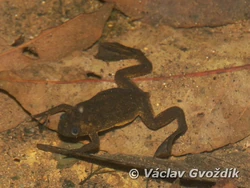| Lake Oku Clawed Frog | |
|---|---|
 | |
| Information | |
| Range | Lake Oku, a small crater lake in northwest Cameroon. |
| Scientific Classification | |
| Kingdom | Animalia |
| Phylum | Chordata |
| Class | Amphibia |
| Order | Anura |
| Family | Pipidae |
| Genus | Xenopus |
| Species | Xenopus longipes |
| Conservation Status | |
 Critically Endangered | |
The Lake Oku clawed frog (Xenopus longipes), is a species of frog in the Pipidae family. Largen's Clawed Frog
Description
Lake Oku clawed frogs are small, with males growing to an average of 28-31 mm and females 32-36 mm. The name results from the claws at the ends of its two hind feet. Its back is brown, the belly is speckled black on an orange background. These frogs also have an unusually high number of chromosomes, 12 sets. It is fully aquatic, never observed to come out of the water.
Distribution
The Lake Oku clawed frog lives exclusively in Lake Oku, a small crater lake in northwest Cameroon.
Conservation
The Lake Oku clawed frog was assessed to be critically endangered during the IUCN's 2004 Global Amphibian Assessment. This is because of its small range-size (one single crater lake) and the likelihood that fish could be introduced to the lake.
The lake in which it lives and the surrounding forest are an official government protected area (a "Plantlife Sanctuary"). This and the wider Kilum-Ijim forest (about 20,000 ha) have been subjected to a community forest conservation project facilitated by BirdLife International, the core work concluding in the early 2000s, but with minor projects continuing. The population of Xenopus longipes has been studied by researchers in collaboration with the local community since 2006, including studying the lake's ecology. Conservation breeding populations have been established at several zoos. Efforts are being made by London, Cologne (and previously Antwerp) Zoos to establish a captive breeding program for Xenopus longipes.
